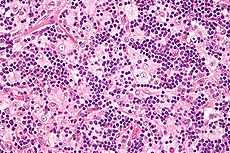Rosai–Dorfman disease
| Rosai-Dorfman disease | |
|---|---|
 | |
| Classification and external resources | |
| ICD-10 | D76.3 (ILDS D76.360) |
| DiseasesDB | 31419 |
Rosai–Dorfman disease, also known as sinus histiocytosis with massive lymphadenopathy, is a rare disorder of unknown etiology that is characterized by abundant histiocytes in the lymph nodes throughout the body.[1],[2]
Presentation
Lymphadenopathy of the neck is the most common place of histiocyte accumulation, although accumulation outside of lymph nodes may occur, as well. The most common sites of accumulation outside of the lymph nodes are skin, upper respiratory tract, and the sinuses.[3][4] The disease can be also diagnosed in thyroid gland.[5]
The symptoms of this disease vary with the site of accumulation similar to other regional tumors. For instance, accumulation in closed spaces such as the cranium can lead to poor outcomes compared to growth in the dermis of an extremity where surgical excision is possible.
The disease is usually non-progressive and self-limited, but patients can manifest autoimmune hemolytic anemia. It can rarely present with massive hemoptysis. [6] Extra nodal sites such as skin, mucosae, spinal cord and pancreas may be involved.[1]
History
This condition has been named after Ronald F. Dorfman and Juan Rosai. An alternative eponym of this condition is known as Destombes-Rosai-Dorfman syndrome, part of which is named after Pierre-Paul Louis Lucien Destombes.
See also
References
- ↑ 1.0 1.1 Riyaz, Najeeba; Khader A (2005). "Rosai Dorfman Syndrome". Indian Journal of Dermatology, Venerology and Leprology 71 (5): 342–344. doi:10.4103/0378-6323.16786. PMID 16394460. Retrieved 2 December 2013.
- ↑ James, William D.; Berger, Timothy G.; et al. (2006). Andrews' Diseases of the Skin: clinical Dermatology. Saunders Elsevier. ISBN 0-7216-2921-0.
- ↑ Foucar E, Rosai J, Dorfman R (1990). "Sinus histiocytosis with massive lymphadenopathy (Rosai-Dorfman disease): review of the entity". Semin Diagn Pathol 7 (1): 19–73. PMID 2180012.
- ↑ Walid MS, Grigorian AA (2010). "Ethmo-spheno-intracranial Rosai-Dorfman disease". Indian J Cancer 47 (1): 80–81. doi:10.4103/0019-509X.58870. PMID 20071801.
- ↑ Lee FY, Jan YJ, Chou G, Wang J, Wang CC. (2007). "Thyroid involvement in Rosai-Dorfman disease.". Thyroid 17 (5): 471–6. doi:10.1089/thy.2006.0192. PMID 17542678.
- ↑ Journal, Chest; Lakshmi Varadarajalu, MD; Sunder Thirugnanasambandan, MS; Paul Jude Thangaraj, MS; Ashok Parameswaran, MD; Meghena Mathew*, MBBS (October 2012). "A Rare Presentation of Rosai Dorfman Disease". Chest. 4 142 (meeting abstracts): 998A–998A. doi:10.1378/chest.1389638.
| ||||||||||||||||||||||||||||||||||||